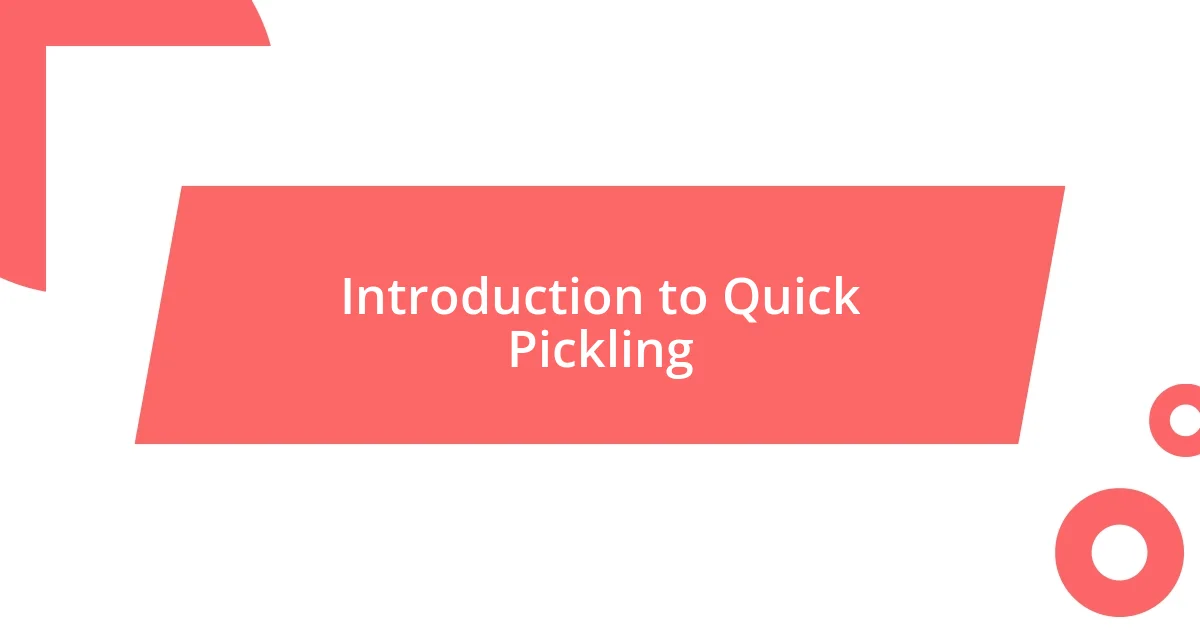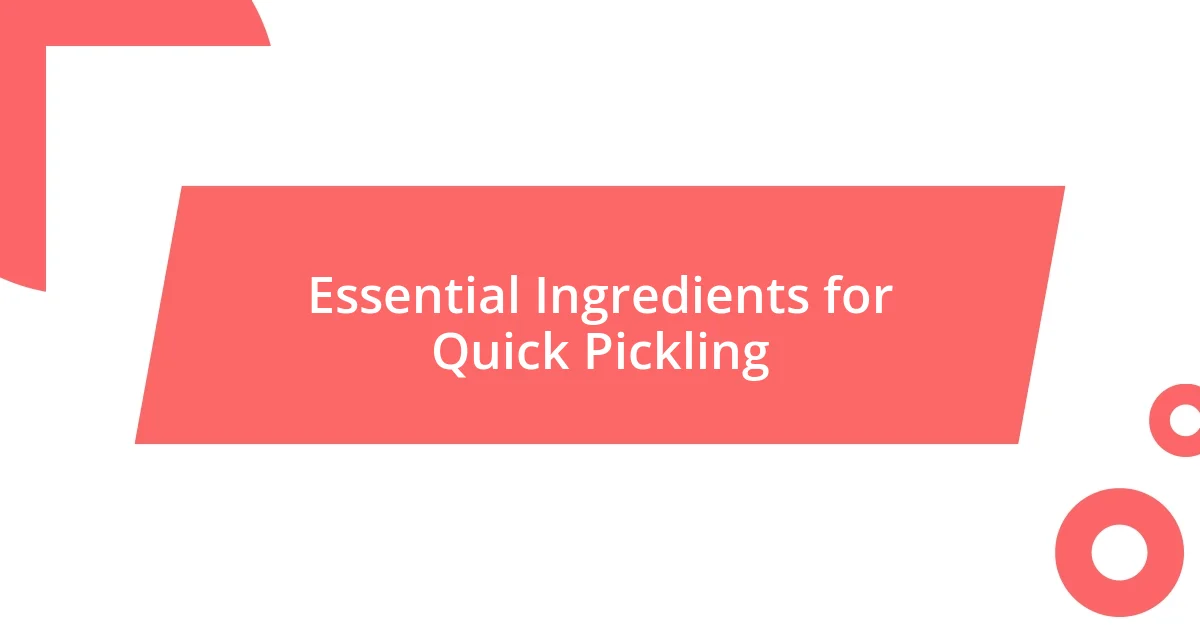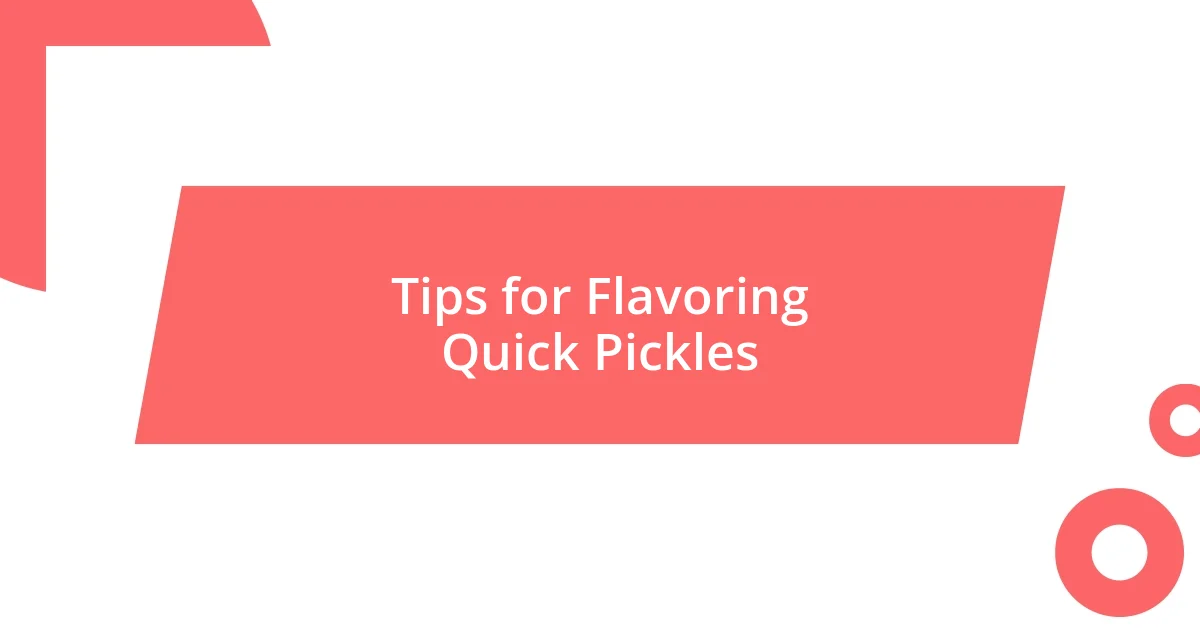Key takeaways:
- Quick pickling is a fast and versatile method for preserving vegetables, allowing for immediate enjoyment and creativity in flavor combinations.
- Essential ingredients include vinegar, sugar, salt, and spices, which are key to creating a balanced and flavorful brine.
- Popular vegetables for quick pickling include cucumbers, carrots, and radishes, each offering unique flavors and textures when pickled.

Introduction to Quick Pickling
Quick pickling is a delightful kitchen technique that allows you to preserve your favorite vegetables in a flash. I remember the first time I tried it; I was overwhelmed with excitement as I transformed a jar full of vibrant cucumbers into crunchy, tangy pickles within hours. It’s that immediate gratification that really hooked me on this method—who doesn’t love a quick yet delicious way to elevate a dish?
What I find fascinating about quick pickling is its versatility. You can pickle just about anything—carrots, radishes, or even fruit like peaches. Have you ever thought about how a simple jar of pickles can bring an unexpected pop of flavor to a bland meal? Quick pickling offers a creative outlet in the kitchen that lets you experiment with different herbs, spices, and brines tailored to your taste.
For me, the act of quick pickling is almost meditative. The repetitive motions of chopping, mixing, and pouring bring a sense of calm. I often find myself lost in the process, thinking about family dinners where my grandmother’s pickles were a staple on the table. It’s not just about preserving food; it’s about connecting to memories and creating new ones. So, what will you try to quick pickle next?

Benefits of Quick Pickling
Quick pickling presents a treasure trove of benefits that make it an appealing method for preserving food. One of the biggest advantages is the speed. With traditional pickling, you’d often need to wait weeks for the flavors to meld, but quick pickling allows me to enjoy those tangy delights within hours. I recall making pickled jalapeños for a taco night; just a few hours in the brine added an irresistible zing to every bite.
Another remarkable benefit is the freshness of the ingredients. In quick pickling, you’re working with vegetables at their peak, which means they’re often more nutritious. I vividly remember the sweetness of fresh summer corn I pickled last season. The vibrant colors and crisp textures not only looked inviting but also tasted like sunshine in a jar. When you quick pickle, you maintain that fresh essence, which enhances both flavor and healthiness.
Lastly, quick pickling offers a creative outlet that can reduce food waste. I find myself using up leftover vegetables and herbs from my fridge that would otherwise be tossed aside. For example, I once turned a bunch of wilting radishes into a colorful batch of pickles. It’s satisfying to know that I’m extending the life of my food while also experimenting with unusual flavor combinations, making every meal a little more exciting.
| Benefit | Description |
|---|---|
| Speed | Enjoy preserved flavors in just hours rather than weeks. |
| Freshness | Utilizes peak-season vegetables for optimal flavor and nutrition. |
| Creativity | Turns leftover ingredients into flavorful dishes, reducing food waste. |

Essential Ingredients for Quick Pickling
When diving into the essentials for quick pickling, it’s crucial to focus on the basics for a successful brine. The foundation of any quick pickle is vinegar, which provides that beloved sharpness. I still remember the first time I experimented with apple cider vinegar; it added a delightful sweetness to my pickled beets that had everyone asking for seconds. Beyond vinegar, sugar and salt are vital for balancing flavor. They help bring out the natural sweetness of the vegetables and ensure they’re seasoned throughout.
Here’s a quick rundown of essential ingredients for quick pickling:
- Vinegar: Choose a type (like white, apple cider, or rice vinegar) to set the flavor profile.
- Sugar: Adds sweetness; I often adjust the amount based on the vegetable’s natural sugars.
- Salt: Essential for seasoning; kosher salt or pickling salt works best.
- Water: Often needed to dilute the vinegar but keep the ratio balanced.
- Spices and Herbs: Get creative! I love adding dill and mustard seeds for a more complex flavor.
These ingredients come together to create a brine that not only preserves but enhances the essence of the vegetables, giving you a jar full of delicious memories.

Common Vegetables for Quick Pickling
When it comes to quick pickling, some vegetables shine brighter than others. Cucumber slices seem to be the most popular for a reason; the crunch and freshness create a delightful contrast with the tangy brine. I remember the first time I quick pickled a batch of cucumbers — they vanished at a barbecue before I even had a chance to savor one!
Carrots, too, are a fantastic choice; their natural sweetness intensifies when immersed in a brine. I once used leftover baby carrots from a vegetable platter, and after a quick soak, they transformed into a vibrant snack that brightened up my lunches for a week. Have you ever felt that rush of creativity when repurposing leftovers? It’s a game changer!
Radishes are another underappreciated gem for quick pickling. Their peppery bite mellows beautifully, making them a zesty addition to salads or tacos. The first time I pickled radishes, I was surprised by how quickly they transformed; within hours, they had become a colorful topping that added a pop of flavor to simple dishes. Who knew pickling could turn a humble radish into a culinary star?

Tips for Flavoring Quick Pickles
Flavoring quick pickles is where the magic happens, and it all starts with spices and herbs. I love experimenting with different combinations, and one of my all-time favorites is adding a pinch of red pepper flakes. The first time I tried this, I was astounded by how a simple touch of heat elevated the entire jar. Have you ever thought about how a little bit of spice can completely change your experience? It’s truly transformative.
Another tip is to consider the acidity balance; it’s not just about the vinegar. Recently, I made a batch of quick pickled onions, and I decided to add a splash of lemon juice for an extra zing. The bright flavor took those onions to a whole new level, turning them into the highlight of my tacos. Just imagine how little adjustments can create a personal touch in your pickling journey!
Don’t forget about the power of infusing flavors over time. I once made pickles with fresh herbs like thyme and rosemary, and I let them sit for a week before diving in. The result was a depth of flavor that left me craving more. It’s funny how patience pays off; have you ever noticed that, too? Taking the time to let those flavors mingle can lead to a pickle that tells a story all on its own.















